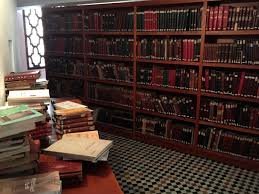The Oldest Library in the World: A Historical Landmark
Libraries have been crucial in preserving knowledge and shaping civilizations throughout history. The oldest library in the world, still in operation today, stands as a testament to human curiosity, intellect, and the pursuit of learning. Located in Al-Qarawiyyin, Morocco, this library has an extraordinary history that dates back over 1,200 years. In this article, we will explore its rich legacy, its contribution to the spread of knowledge, and why it continues to be a significant institution in today’s world.
Al-Qarawiyyin Library: The Oldest in the World
The Al-Qarawiyyin Library, founded in 859 AD, is the oldest continually operating library globally. It is situated within the University of Al-Qarawiyyin, which is recognized by UNESCO and the Guinness World Records as the world’s oldest degree-granting university. Initially established by Fatima al-Fihri, a woman with a deep vision for knowledge and education, the library was intended to serve as a center for theological, scientific, and philosophical learning.
The library houses an extensive collection of manuscripts, books, and historical documents that span multiple centuries. Many of these materials are irreplaceable, offering a glimpse into the intellectual advancements of the past. This extraordinary resource has attracted scholars from across the globe, and it continues to be an important academic hub.
Importance of Al-Qarawiyyin Library in Modern Times
In today’s world, the Al-Qarawiyyin Library not only serves as a symbol of educational history but also plays a pivotal role in preserving knowledge. With a renewed focus on the digitization of ancient texts, the library has embarked on projects that aim to make its collections more accessible to the global community. This effort ensures that the legacy of knowledge contained within its walls remains relevant in the modern era.
For students preparing for government exams, particularly in subjects such as history, culture, and heritage, understanding the significance of this library is crucial. It is a prime example of the enduring value of education and learning, which has persisted for over a millennium. Additionally, students can gain insight into the development of early educational systems and the role libraries played in the dissemination of knowledge.

Why This News is Important
Al-Qarawiyyin’s Role in Knowledge Preservation
The Al-Qarawiyyin Library’s claim to fame as the oldest functioning library in the world underscores the importance of preserving knowledge for future generations. In an era where information is increasingly digitized and disseminated globally, the history of libraries like Al-Qarawiyyin is a reminder of how crucial it is to safeguard intellectual property. Its collection includes manuscripts that contributed significantly to the development of fields like astronomy, medicine, and philosophy.
Cultural and Historical Significance
For students preparing for civil services or other competitive exams, understanding the historical and cultural context of such institutions is vital. The Al-Qarawiyyin Library is not just a repository of knowledge but also a part of the broader cultural heritage of Morocco and the Arab world. By studying such institutions, candidates can gain a deeper appreciation for the educational traditions that have influenced modern-day learning systems.
Impact on Modern Education
As the world shifts toward more digital forms of learning, institutions like Al-Qarawiyyin remind us of the roots of educational systems. The preservation efforts at the library demonstrate the importance of maintaining historical records while adapting to technological advancements. This intersection of tradition and modernity offers important insights for students looking to understand the evolution of education.
Historical Context:
The Al-Qarawiyyin Library has a rich history dating back to 859 AD, a time when intellectual exploration flourished in the Islamic Golden Age. Founded by Fatima al-Fihri, a woman who was ahead of her time, the university and its library became a cornerstone of knowledge, attracting scholars from all corners of the world.
Initially, the library focused on Islamic studies, including Quranic studies, law, and theology. However, over the centuries, its collection expanded to include a diverse range of subjects, including philosophy, astronomy, medicine, and mathematics. This made it one of the most important centers for academic activity during the medieval period.
The library’s role in the Islamic Golden Age is significant because it was part of a broader intellectual movement that translated, preserved, and built upon the works of ancient Greek, Roman, and Persian scholars. These translations later influenced the European Renaissance, creating a lasting impact on the global intellectual landscape.
Key Takeaways from “The Oldest Library in the World”
| S.No | Key Takeaway |
|---|---|
| 1 | The Al-Qarawiyyin Library, founded in 859 AD, is the oldest continuously operating library in the world. |
| 2 | The library was established by Fatima al-Fihri, a woman with a vision for creating an institution of learning and preserving knowledge. |
| 3 | The library’s collection includes manuscripts on subjects such as astronomy, medicine, and philosophy, making it a key intellectual hub. |
| 4 | Al-Qarawiyyin Library is part of the University of Al-Qarawiyyin, which holds the distinction of being the world’s oldest continuously operating degree-granting university. |
| 5 | The library has undergone efforts for digitization, ensuring that its vast collection remains accessible to the global community in the modern age. |
Important FAQs for Students from this News
1. Where is the oldest library in the world located?
The oldest library in the world is located in Fez, Morocco, at the University of Al-Qarawiyyin. It was founded in 859 AD and is still operational today.
2. Who founded the Al-Qarawiyyin Library?
The library was founded by Fatima al-Fihri, a woman who established the library with a vision to create an institution that would preserve and promote knowledge.
3. What makes the Al-Qarawiyyin Library significant?
Al-Qarawiyyin is the oldest continually operating library in the world. It played a crucial role during the Islamic Golden Age in preserving and disseminating knowledge in various fields such as astronomy, medicine, and philosophy.
4. What kind of manuscripts can be found in the Al-Qarawiyyin Library?
The library’s collection includes ancient manuscripts on a wide array of subjects including Islamic studies, philosophy, medicine, astronomy, and mathematics.
5. How has the Al-Qarawiyyin Library contributed to modern education?
The library’s preservation efforts, along with its ongoing digitization projects, have made its vast collection more accessible to a global audience, bridging the gap between traditional knowledge and modern-day learning methods.
6. Why should students preparing for exams focus on the Al-Qarawiyyin Library’s history?
Understanding the historical and cultural context of institutions like Al-Qarawiyyin offers insights into the intellectual advancements that have shaped global educational traditions, making it relevant for subjects in history and general knowledge exams.
Some Important Current Affairs Links

















